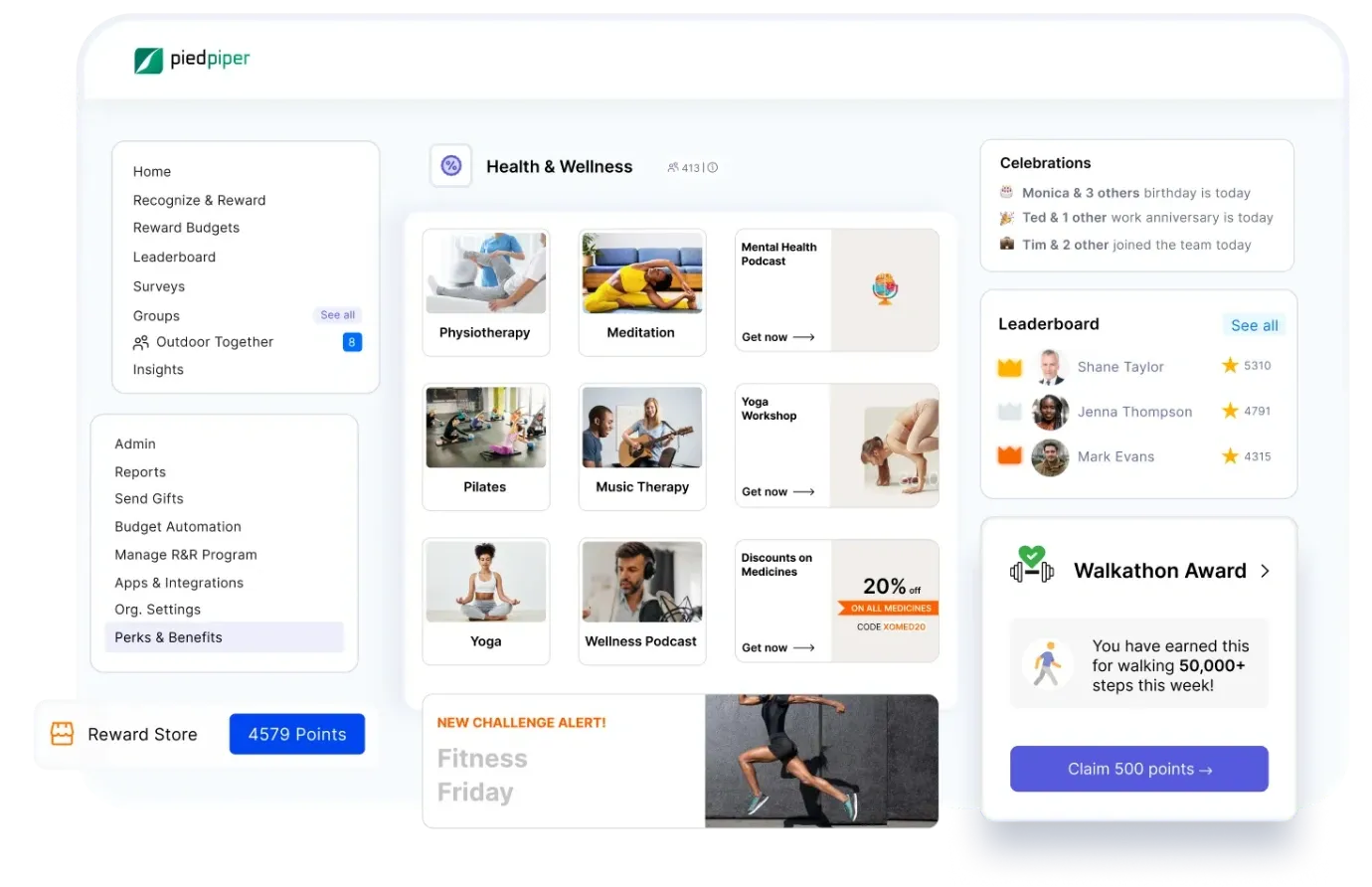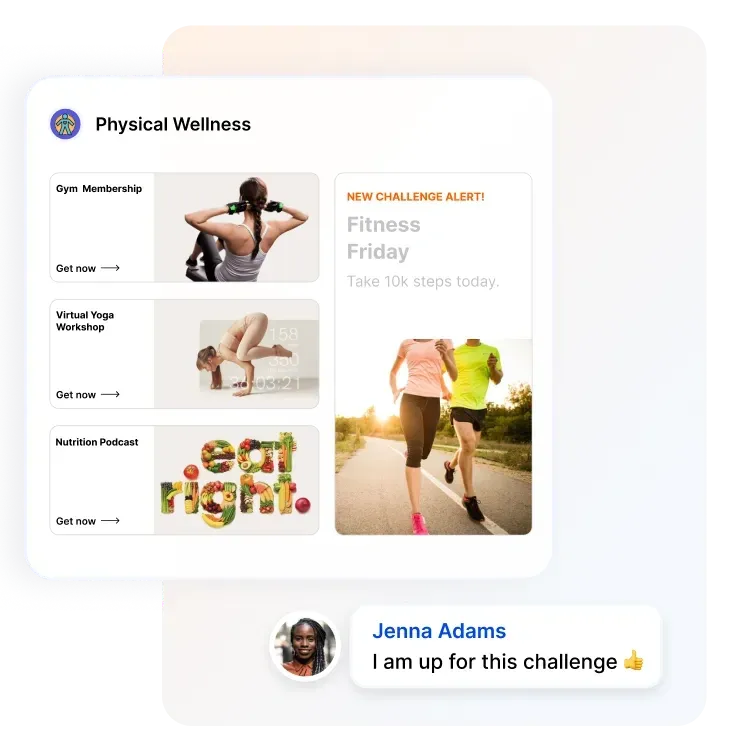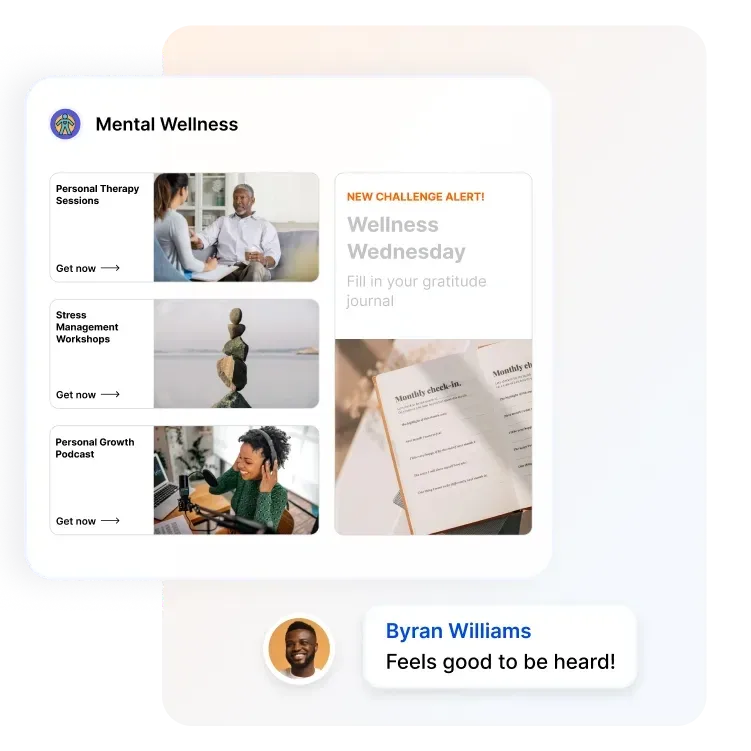The Ultimate Guide to Building an Effective Employee Wellbeing Program
An employee wellbeing program enhances productivity, engagement, and retention. Learn how to create a workplace culture that prioritizes employee well-being and success.
Pada halaman ini
- Understanding employee wellbeing programs
- Faedah program kesejahteraan pekerja
- Faktor-faktor yang mempengaruhi kesejahteraan pekerja
- Bagaimana untuk tidak mewujudkan program kesejahteraan tempat kerja?
- Then how do you create effective employee wellbeing programs?
- Top 8 employee wellbeing programs to implement in 2025
- How Empuls enhances employee wellbeing programs
- Kesimpulan
Setiap perniagaan mahu pekerjanya bahagia dan sihat. Itulah sebabnya begitu banyak perniagaan kecil dan syarikat besar hari ini mula memikirkan bagaimana mereka dapat menyumbang kepada kesihatan dan kesejahteraan pekerja.
Since people spend so much of their lives at work, this is a very vital concern for employers.
Dan memberi tumpuan kepada kesihatan mental dan kesejahteraan pekerja di tempat kerja bukan hanya sesuatu yang terasa bagus untuk disediakan - ia sebenarnya bermanfaat untuk banyak bidang perniagaan anda.
So if you want to keep your best employees and help them do great work, you need to focus on improving employee well-being. But let’s be honest - there are plenty of poorly designed health and wellbeing programs for employees out there.
Jadi bagaimana anda boleh memastikan anda mencipta satu yang sebenarnya akan berterima kasih kepada pekerja anda? Lagipun, program kesejahteraan tempat kerja hanya berfungsi dengan baik apabila pekerja sering mengambil bahagian dan bersemangat.
Tidak perlu takut - kami di sini untuk membimbing anda melalui semua yang anda perlu tahu tentang mewujudkan program kesejahteraan yang akan disukai oleh pekerja anda.
Mari kita mulakan!
Understanding employee wellbeing programs
Employee wellbeing programs focus on improving the physical health of employees at your company.
Mereka kelihatan sedikit berbeza di setiap organisasi, tetapi kebanyakannya termasuk ciri-ciri seperti program berhenti merokok, diskaun keahlian gim, makanan ringan pejabat yang sihat, pertandingan langkah, dan banyak lagi.
Many wellbeing programs are also now beginning to focus on mental health as well as physical. By implementing programs like EAP (Employee Assistance Programs), stress reduction programs, meditation programs, and more.
Ini semua tentang meningkatkan kesihatan pekerja dengan menjadikannya lebih mudah dan lebih murah untuk menjalani gaya hidup yang sihat.
Faedah program kesejahteraan pekerja
Mengapa majikan melabur dalam program ini? Mereka boleh agak mahal, bergantung kepada program mana yang dipilih oleh organisasi anda.
Tetapi walaupun kos dan usaha yang diperlukan untuk melaksanakannya, mereka sering sangat berkesan dan mempunyai pulangan pelaburan yang besar.
Ini kerana pekerja yang gembira dan sihat jauh lebih produktif dan terlibat daripada pekerja yang letih, tertekan, bimbang, atau sakit.
Pada tahap asas, menjaga pekerja sihat bermakna mereka tidak sering terlepas kerja, dan itu jelas bagus untuk kejayaan perniagaan anda. Selain itu, kenaikan kos penjagaan kesihatan yang cepat di tempat-tempat seperti AS bermakna pekerja yang jatuh sakit boleh menjadi longkang besar pada sumber syarikat.
Tetapi menjadi produktif dan terlibat bermakna pekerja perlu mempunyai tahap kebimbangan dan tekanan yang lebih rendah dalam kehidupan mereka juga, dan banyak program kesejahteraan pekerja yang lebih maju menanganinya juga.
The World Health Organization says that mental illness is now the leading cause of disability and illness. High levels of chronic stress caused by unhealthy workplace cultures have a real impact on employee engagement and productivity.
No one does their best work when surrounded by stressful conditions. But as sad as that sounds, well-designed employee health and wellness programs can help alleviate many of those problems.
Bukan sahaja pekerja anda akan menjadi lebih sihat dan lebih produktif, tetapi mereka juga akan berasa disokong dan lebih bahagia untuk bekerja di organisasi yang menjaga mereka dengan teliti. Ini bermakna kurang perolehan dan kepuasan kerja yang lebih tinggi juga!
Faktor-faktor yang mempengaruhi kesejahteraan pekerja
Tiga faktor penting meningkatkan kesihatan dan kesejahteraan pekerja di tempat kerja, dan kami akan merangkumi mereka semua secara mendalam hari ini, jadi anda tahu dengan tepat apa yang perlu anda lakukan untuk mempunyai pekerja yang lebih bahagia, sihat, lebih produktif.
1. Kawalan pekerjaan
One of the biggest factors in employee well-being (and employee engagement) is their discretion over what they do and how they do it. That’s the basis of job control.
Limited job control is linked strongly with poorer physical health, including higher death rates, heart disease, and diabetes.
Kawalan pekerjaan juga merupakan faktor penting dalam kesihatan mental. Pelbagai kajian telah mendapati bahawa orang yang mempunyai tahap kawalan pekerjaan yang lebih tinggi mempunyai kebimbangan dan kemurungan yang kurang.
Penemuan ini bermakna bahawa walaupun pekerja peringkat tinggi cenderung melakukan tugas yang lebih tertekan, mempunyai lebih banyak tanggungjawab, dan sering bekerja berjam-jam, mereka mempunyai kesan kesihatan negatif yang lebih sedikit dari kerjaya mereka kerana mereka mempunyai tahap kawalan pekerjaan yang lebih tinggi.
It might seem fairly challenging to increase job control for lower-level workers who are mostly responsible for repetitive, boring tasks where they lack control. But it just takes some imagination to look at a new way to increase job control.
For example, reducing the amount of micromanaging that leaders and managers do is a great first step. While managers certainly need to manage their people, getting too into the details and controlling employees is unhelpful for everyone.
If you’re hiring the right people, you really should be letting them do the jobs they were hired to do with the skills they have and not watching their every move. And even workers infamously tightly controlled phone lines can be given additional autonomy with some creative thinking.
Collective Health empowered its “patient advocates” who answer phones to solve complex patient problems to solve problems on the floor as they come up, instead of giving them a strict script.
This has increased employee retention, satisfaction, and motivation. And it’s proved more efficient at solving customer problems as well - everybody benefits.
2. Motivating employees
Job control doesn’t just affect physical and mental health - it also has a strong impact on how motivated and engaged employees are in their jobs. When employees work in an environment where they don’t have much control over their work or how they get it done, it creates stress and uncertainty.
Mereka mungkin terpaksa mengikuti prosedur yang tidak berkesan atau ketinggalan zaman dan kemudian dihukum kerana hasil yang buruk atau mempunyai matlamat yang ditetapkan untuk mereka yang mustahil untuk dicapai dalam peranan mereka.
Apabila ini berlaku, sukar bagi mana-mana pekerja untuk terus komited untuk pergi ke atas dan seterusnya. Apabila anda tidak merasakan anda mempunyai pemilikan tugas anda, ia mengurangkan kecekapan dan pencapaian.
That’s not a workplace that encourages you to try your best because it probably won’t be recognized or rewarded if you do. Low job control makes workplaces feel chaotic and unpredictable - you don’t have control over your role or tasks, so it’s hard to predict your actions' outcomes. That is a pretty significant demotivator for most employees.
3. Social support
Mempunyai rakan dan rangkaian sosial yang kuat sangat bermanfaat untuk kesihatan dan membantu mengurangkan tekanan, termasuk tekanan di tempat kerja. Tetapi di banyak syarikat, kehidupan di tempat kerja sebenarnya mengurangkan perasaan sokongan sosial dan hubungan.
Bunyi mengejutkan? Bukan apabila anda mempertimbangkan persekitaran di banyak perniagaan teratas. Banyak tempat kerja mempunyai langkah-langkah prestasi yang pit pekerja antara satu sama lain - seperti kedudukan lengkung paksa atau sistem promosi. Hanya bilangan pekerja tertentu yang layak dalam setiap kitaran semakan.
Perniagaan lain melayan pekerja seperti mereka dalam hubungan urus niaga semata-mata, di mana kerja ditukar hanya untuk wang.
4. The right employee wellbeing framework
Apabila kebanyakan majikan memikirkan program kesejahteraan pekerja, mereka memberi tumpuan kepada mendapatkan pekerja untuk mengambil bahagian dalam tingkah laku individu yang lebih sihat sendiri. Ini boleh bermakna berhenti merokok, kurang minum, bersenam lebih banyak, atau makan lebih sihat.
Majikan biasanya meletakkan program-program ini untuk tidak memberi tumpuan kepada keperluan pekerja tetapi untuk menurunkan kos penjagaan kesihatan mereka sendiri. Itulah rangka kerja kesejahteraan pekerja yang salah untuk digunakan.
The drivers of unhappy and unhealthy employees are more often factors in the control of employers - unfair workplace practices, unmanageable workloads, lack of role clarity, poor communication, and not enough time to get work done.
Walaupun mendapat lebih banyak senaman dan bermeditasi pasti dapat mengurangkan gejala tekanan, jika program kesejahteraan pekerja anda tidak menangani punca tekanan itu, anda tidak akan menyelesaikan masalah dengan diskaun gim.
Memberi orang beban kerja yang munasabah dan rasa keadilan di tempat kerja akan pergi lebih lama untuk mengurangkan kos penjagaan kesihatan yang berkaitan dengan tekanan.
Pekerja juga mahukan lebih daripada sekadar diskaun gim untuk menjaga kesihatan mereka - terutamanya jika mereka terlalu letih atau terbakar dari kerja sebenarnya untuk sampai ke gim setiap hari.
5. Improving employee wellbeing
Kesejahteraan pekerja adalah lebih daripada sekadar kebaikan untuk dimiliki. Ia penting untuk kesihatan manusia yang bekerja untuk anda, dan ia juga merupakan pemacu perniagaan yang positif.
Pekerja yang bebas daripada tekanan dan keletihan tempat kerja yang tinggi mempunyai kawalan ke atas tugas mereka, dan hubungan sosial yang kuat di tempat kerja lebih produktif dan terlibat.
Wondering how further to promote that link between employee wellbeing and performance? You can simply ask your employees how they’re regularly feeling to learn how to handle stress at your workplace and what they really want from wellbeing programs. Let’s discuss about employee wellbeing programs.
Bagaimana untuk tidak mewujudkan program kesejahteraan tempat kerja?
Walaupun faedah ini semua mungkin jika anda memilih program kesejahteraan yang betul, mereka keluar tetingkap jika anda memilih yang salah. Apa maksudnya?
Bukankah apa-apa yang dimaksudkan untuk membantu pekerja anda menjadi pilihan yang baik? Bukankah mereka akan bersyukur?
Nah, tidak semestinya. Anda mungkin telah melakukan kerja anda dengan baik dan mengupah beberapa orang yang benar-benar pintar - mereka akan melihat melalui usaha yang memberi manfaat kepada syarikat anda lebih daripada mereka.
Sekiranya program kesejahteraan anda kebanyakannya direka untuk menurunkan premium insurans dengan menghukum pekerja untuk tingkah laku yang tidak sihat, mereka tidak akan gembira - dan mereka tidak akan mengambil bahagian secara aktif seperti yang anda mahukan.
As Deloitte has found, there’s actually often a huge gap between what employers think their people need, and what employees actually want. That’s why doing your research properly is vital before you commit to an expensive and unpopular wellbeing program.
And SHRM notes that focusing exclusively on physical wellness is pretty ineffective for most organizations, so it’s better to think holistically about wellbeing.
Then how do you create effective employee wellbeing programs?
Creating a wellbeing program that truly resonates with employees requires more than good intentions—it demands research, personalization, and employee input. Here’s how to do it right:
1. Start with listening: ask, don’t assume
Instead of making assumptions, directly involve employees in the design process:
- Use surveys to understand what employees value most in wellbeing support.
- Ask about stressors, preferred perks, and areas needing improvement.
Tools like Empuls offer lifecycle, eNPS, and pulse surveys with AI-driven insights to uncover employee needs and track sentiment over time.
2. Identify root causes, not just symptoms
Don’t just encourage healthier habits—address systemic workplace stressors:
- Evaluate workloads, fairness, communication gaps, and leadership quality.
- Prioritize job control, autonomy, and social support, which research shows are core to wellbeing.
- Recognize that burnout isn’t solved with a gym pass—it requires structural fixes.
3. Design holistic, flexible programs
Include a variety of initiatives that support:
- Physical wellness: fitness benefits, step challenges, health screenings.
- Mental wellness: therapy sessions, meditation apps, stress management workshops.
- Financial wellness: salary advance programs, tax-saving perks, early wage access.
- Lifestyle needs remote work support, childcare, and learning allowances.
Empuls offers all of the above via customizable Lifestyle Spending Accounts (LSA) and fringe benefits across 50+ countries.
4. Ensure inclusivity & personalization
Avoid one-size-fits-all approaches. Offer choice and flexibility in benefits—e.g., wellness options, rewards, and discounts that reflect different life stages and preferences.
Empuls enables modular configuration of wellbeing programs based on roles, locations, and demographics.
5. Communicate transparently
Even the best program fails without awareness. Ensure clear communication on what's offered and how to access it.
Use internal communication platforms like Empuls Social Intranet to drive awareness, updates, and engagement.
6. Automate for consistency & scale
Automate key touchpoints like:
- Birthday wishes, service anniversaries, wellness nudges, and rewards
- Personalized milestone recognitions to show continuous care
Empuls supports automated workflows and AI nudges to streamline delivery and ensure no moment is missed.
7. Measure impact & iterate
Track participation, sentiment, and ROI:
- Use analytics dashboards to identify what’s working and what’s not.
- Iterate based on continuous feedback to improve adoption and effectiveness.
Empuls provides real-time reporting and people analytics to measure program performance and engagement levels.
By co-creating programs with employees, aligning with their actual needs, and leveraging platforms like Empuls for automation, insights, and personalization, your wellbeing initiatives will be not only effective—but genuinely appreciated.
Top 8 employee wellbeing programs to implement in 2025
Sekarang bahawa anda tahu faedah - dan perangkap - program kesejahteraan pekerja, yang mana yang harus anda pertimbangkan?
Berikut adalah beberapa program kesejahteraan terbaik yang pekerja anda sebenarnya akan berterima kasih kepada anda kerana melaksanakan. Ini bukan hanya idea kami - mereka disokong oleh apa yang benar-benar dikehendaki oleh pekerja di seluruh dunia (tetapi jangan lupa untuk memeriksa dengan pekerja anda sendiri juga!).
1. Flexible work schedules
Ini mungkin tidak memberi manfaat kepada anda sebagai kesejahteraan - tetapi benar-benar, pekerja lebih bahagia dan sihat apabila mereka mempunyai lebih banyak kawalan ke atas di mana dan bila mereka bekerja.
With so many options for designing flexible work schedules that work for your business, you can provide flexibility and autonomy for your employees so they better balance their work and life together. In fact, Harvard Business Review says that employees thrive when they’re offered these options.
2. Healthy office snacks
Ramai majikan berpendapat bahawa mereka melakukan perkhidmatan yang hebat kepada pekerja dengan menyediakan biskut dan gula-gula untuk orang ramai makan di tempat kerja. Walaupun ini mungkin memuaskan dalam jangka pendek, pekerja sebenarnya mahukan pilihan yang lebih sihat disediakan.
Google provides low-cost healthy snacking options in all of its offices, which employees love. And healthy snacks prevent the mid-afternoon sugar crash from sapping productivity out of your employees too.
3. Wellness counseling
Menjadi sihat dan sihat boleh mencabar dalam dunia kita yang pantas dan cepat dipenuhi makanan. Pekerja yang ingin menjadi sihat mungkin sukar untuk mengetahui dengan tepat langkah-langkah yang perlu diambil.
Itulah sebabnya kaunseling kesihatan telah menjadi begitu popular sebagai program kesejahteraan tempat kerja - pekerja boleh mendapatkan bimbingan adat dan membantu menjalani kehidupan yang lebih sihat dengan syarat mereka sendiri.
4. Mental health counseling
Mendapatkan bantuan apabila kesihatan mental anda menderita sering sukar di banyak tempat. Tetapi kesihatan mental yang buruk boleh membawa kepada masalah serius dalam kerja dan kehidupan peribadi.
Membantu pekerja anda mengakses kaunseling kesihatan mental adalah sangat popular di kalangan pekerja dan juga perkara yang penuh belas kasihan untuk dilakukan - jadi adalah idea yang bagus untuk memikirkan bagaimana ini adalah sesuatu yang boleh anda tawarkan.
5. Parental support
Being a working parent is hard for both mothers and fathers. It can be a big challenge to balance work and childcare every day. In fact, US employers lose about $13 billion a year due to lost productivity and earnings due to inadequate childcare.
Menawarkan sokongan, seperti cuti ibu bapa berbayar yang murah hati, makanan tambahan penjagaan anak, pilihan penjagaan anak sandaran, dan banyak lagi boleh membuat perbezaan besar dalam kehidupan ibu bapa yang bekerja untuk anda, dan mereka cenderung menjadi pekerja yang sangat setia sebagai tindak balas.
6. Destressing programs
Tekanan di tempat kerja adalah isu yang besar dan semakin meningkat di banyak tempat - mungkin juga kebanyakan - syarikat. Walaupun anda telah melakukan usaha yang signifikan untuk mewujudkan budaya tempat kerja yang sihat dan menyokong, tekanan masih boleh menjalar pada masa-masa semasa musim sibuk atau sekitar projek besar.
Managing that stress can be hard alone, so implementing programs that help employees learn how to deal with stress can be a big benefit. This could be yoga classes, tai chi, meditation lessons, or other relaxation techniques - Wegman’s offers customized yoga plans for employees, for example.
7. Community involvement
Memang benar - pekerja benar-benar menghargai dapat menyumbang kepada komuniti mereka! Memberi mereka cuti berbayar untuk menjadi sukarelawan atau menganjurkan hari sukarelawan dengan pasukan anda pergi jauh untuk membuat pekerja anda berasa gembira dan disokong.
Plus, it benefits the larger community and the image of your business as well. Liberty Mutual Insurance offers annual days of service called Serve with Liberty, which half of their employees across the globe participate in.
How Empuls enhances employee wellbeing programs

Empuls helps organizations design effective employee wellness programs by addressing both physical and mental well-being. With a data-driven approach, it enables HR teams to build workplace wellbeing programs that employees appreciate and actively engage with.
1. Physical wellness: Supporting a healthier workforce

Empuls promotes employee wellbeing by offering flexible options for physical health, allowing employees to choose what suits them best. From fitness challenges with rewards to gym memberships, virtual yoga classes, and nutrition consultations, employees can access a variety of wellness resources that align with their personal health goals. With Empuls, you get:
- Fitness challenges, gym memberships, and yoga classes
- Mental wellness tools: stress management workshops, therapy sessions, meditation apps
- Flexible fringe benefits: Lifestyle Spending Accounts (LSA) for health, travel, meals, learning
2. Mental wellness: Reducing stress and improving focus

To help employees manage stress, Empuls integrates mental wellness solutions into employee wellbeing programs. Companies can offer personal therapy sessions, stress management workshops, and meditation app subscriptions to help employees improve sleep, breathing, and overall mental resilience.
3. Comprehensive benefits for both employees and employers
For HR teams: Fully customizable to fit company-wide workplace wellbeing programs. Scalable across locations and available on all devices. A robust reporting suite with 24/7 access to data-backed insights and actionable recommendations.
For employees: Holistic support across personal, financial, physical, and mental wellness. Exclusive discounts and extended coverage beyond standard insurance. 24/7 customer support, including multilingual assistance, chat support, and a help center.
By leveraging Empuls’ employee wellness solutions, businesses can create a culture that prioritizes employee wellbeing, enhances engagement, and reduces workplace stress, leading to a happier and more productive workforce. Schedule a call now!
Kesimpulan
Creating an effective employee wellbeing program isn’t just a checkbox exercise—it’s a strategic investment in your company’s most valuable asset: your people. When employees feel physically healthy, mentally supported, financially secure, and socially connected, they bring their best selves to work. The result? A thriving workplace culture, lower attrition, and higher performance across the board.
But getting wellbeing right requires more than good intentions—it demands the right tools, data, and flexibility to meet the diverse needs of your workforce.
That’s where Empuls makes a real difference.
Empuls helps you design, manage, and scale impactful wellbeing initiatives with an AI-powered, data-backed platform that’s loved by both HR leaders and employees alike. From flexible benefits and mental health resources to global perks and continuous feedback loops, Empuls empowers you to build a culture where everyone can do their best work—and feel great while doing it.
Ready to create a workplace your employees won't want to leave? Start your journey with Empuls today. Schedule a call now!











